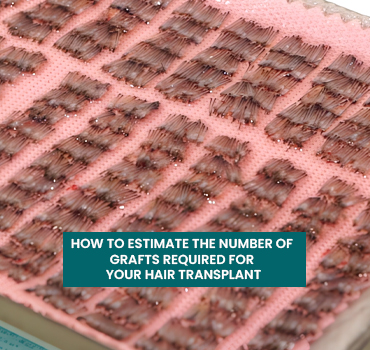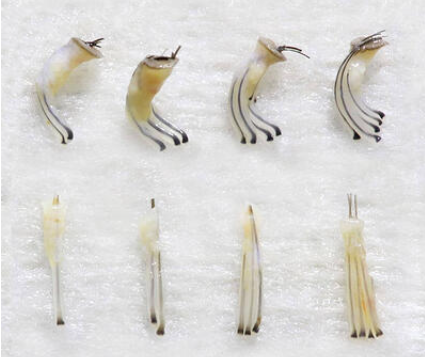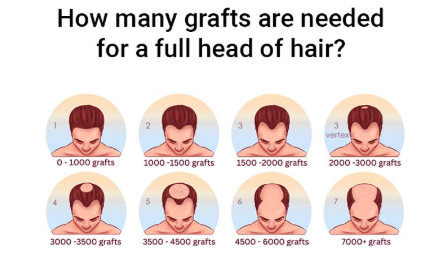How to Estimate the Number of Grafts Required for Your Hair Transplant

Hair loss can be disheartening, affecting both your appearance and self-esteem. Fortunately, medical advances have made hair transplant procedures with the DHITM – Direct Hair Implantation technique a reliable, permanent, and long-term solution that not only restores hair but also boosts confidence and self-esteem.
One of the most important steps before undergoing hair transplant treatment is understanding how many hairs or grafts you’ll likely need. Knowing this helps set realistic expectations and allows for a more personalized hair transplant treatment plan.
In this blog, we’ll explain what a hair graft is, highlight the key factors that determine graft requirements, and walk you through how specialists calculate the ideal graft count for natural, effective results.
What is a Hair Graft?

Ahair graft refers to a group of one to four hair follicles extracted from the donor area during a hair transplant procedure. The donor area is usually the back side of the scalp. These grafts are then carefully segregated into one, two, three, and four hair follicles and then implanted into balding or thinning areas of the scalp. It’s important to note that a graft is not the same as a single hair; each graft can contain multiple hairs, depending on the natural grouping. Achieving a natural-looking hairline with high density starts with precise planning during the hair implantation process. By carefully segregating grafts and strategically placing individual hair follicles, hair restoration experts can create a more realistic and fuller appearance. This advanced technique not only improves the aesthetic outcome but also ensures better coverage and long-lasting results. When it comes to successful hair transplant results, the quality and strategic placement of hairs play a crucial role. Proper graft handling ensures higher survival rates, while accurate implantation determines how natural and dense the hair looks after the procedure. Whether you’re considering a DHITM hair transplant technique, understanding these factors is essential to achieving long-lasting, natural-looking results.
In the DHITM (Direct Hair Implantation) hair transplant technique, the extraction and implantation processes are highly precise and minimally invasive. Here’s a detailed explanation of each step:
1. Graft Extraction
Tool Used: A specialized micromotor or manual punch tool with a diameter of 0.6mm to 1.0mm.
Process:
The donor area (usually the back of the scalp) is shaved and numbed with local anesthesia.
Individual hair follicles (grafts) are extracted one by one using the punch tool.
Each extracted follicle is carefully separated in ones, twos, threes, fours, and preserved in a specialized solution to maintain vitality.
DHITM uses a no-scalpel, no-stitches hair implantation method.
2. Follicle Implantation
Tool Used: A patented DHITM implanter.
Process:
Each follicle is loaded into the advanced implanter.
The implanter is then used to implant the follicle simultaneously.
The angle, depth, and direction of each follicle are controlled precisely by the surgeon to achieve a natural-looking hairline and maximum density.
Unlike traditional techniques, no recipient site incisions are made in advance — implantation and incision happen in one motion.
Advantages of the DHITM Technique
Minimally invasive: No scalpel, stitches, or linear scars.
Faster recovery: Less trauma to the scalp.
Higher graft survival rate: Because follicles spend minimal time outside the body.
Natural results: Precise control over angle, direction, and placement.
Factors that Influence the Number of Hairs Required

Several key factors influence how many grafts are needed in a hair transplant:
- Degree of Hair Loss: The extent of hair loss is usually measured using the Norwood Scale for men and the Ludwig Scale for women. The higher the stage, the more hairs are required.
- Size of the Balding Area: The actual size of the area to be covered plays a direct role in follicle count. The larger the area to be covered, the more hairs you will typically need.
- Hair Characteristics: Thickness, texture, and curliness affect how well each hair covers space; coarser or curlier hair often provides better coverage, requiring fewer hairs.
- Donor Hair Density: The amount and quality of hair you have in the donor area (typically the back of the scalp) sets the upper limit on how many hairs can be implanted safely.
- Desired Look: Your desired result, natural and maximum density, also determines the number of hairs required.
- Expertise of the Surgeon: An experienced hair transplant surgeon can design an efficient hair grafting procedure, maximizing results with minimal hairs.
These elements together help create a custom approach that balances aesthetics, safety, and long-term outcomes.
Approximately How Many Hairs Do You Need at Each Hair Loss Stage
The number of hairs needed can vary based on the stage of hair loss. According to the Norwood scale:
- Stage 1 & 2: Depends on the density & if the client wants hairline lowering. Sometimes hair is very thick & the ratio of grafts vs hair is high. We need 1500 to 2000 grafts, which means 3500 to 4500 hairs.
- Stage 3: Minimum 3500 to 4500 hairs from the frontal scalp (hairline & temples), if the crown also demands hair transplant, then hairs will increase
- Stage 4: 3500 to 4000 hairs for the hairline & temples & Additional 3500 to 4000 hairs for the crown area. Ideal grade 4 cases.
- Grade 5+: Depends on donor area, 5000 open-ended to max 10-12k hairs
These are general estimates, as each person’s scalp and hair loss pattern is unique. Someone with thick donor hair may need fewer follicles and grafts than a person with fine, straight hair. For example, someone seeking hairline grafting alone may only require a few hundred grafts and a few thousand hairs, while someone aiming to cover the crown and front will need more. Before-and-after results often show dramatic improvement, even with a modest number of follicles, when strategically placed.
How Many Hair Grafts Do You Need? A Surgeon’s Guide to Follicles Calculation

If you are considering a hair transplant treatment, one of the most common questions is: How many hair grafts will I need? Understanding how surgeons calculate the required number of grafts is essential for setting realistic expectations about your hair restoration journey.
Hair graft calculation isn’t guesswork; it’s a scientific process based on various factors like the extent of your hair loss, the density you desire, and the availability of donor hair. In this blog, we’ll explain how experienced surgeons estimate the number of hairs, the techniques they use, and how this impacts the final results of your hair transplant.
Skilled and experienced surgeons use a mix of digital scalp analysis (Unique Diagnosis Alopecia Test) and manual assessments to determine how many grafts are needed. First, they evaluate the scalp’s surface area using software. Then, they estimate the desired hair density per square centimeter, often between 30 to 50 grafts/cm² for a natural look. Combining these gives an overall graft and follicle number. A hair graft calculator may also be used to give an approximate estimate of requirement of hairs for implantation. These calculations consider both the coverage area and the available donor hair. Consultation and personalized treatment planning are crucial for a natural-looking, lifetime with maximum density or a fuller head of hair. Personalized plans help ensure that each graft and hairs are used effectively and account for future hair loss. Clinics that focus on precision and hair loss consultations and diagnosis of hair loss, such as those specializing in hair transplants in India, prioritize accuracy in this step to ensure natural results that age well.
Is It Possible to Adjust Graft Numbers During a Hair Transplant?
Yes, the number of grafts can be tailored to fit your goals, to achieve a fuller head of hair, and the availability of donor hair. Some people may opt for less density to reduce cost or because their donor area is limited. Others may choose to focus on one area first and undergo a second session later. It’s a balance between coverage and density. Long-term planning is essential because hair fall may continue after the transplant. Surgeons often design procedures that leave enough donor hair for future needs. This flexibility makes a well-planned hair grafting procedure both strategic and sustainable.
Conclusion
Accurate graft calculation is vital for a successful hair transplant procedure. It ensures optimal coverage without depleting valuable donor hair. Always consult a qualified surgeon for a personalized treatment plan tailored to your specific needs.
If you’re exploring options, clinics like DHI™ offer expert diagnosis and tailored solutions for natural, long-lasting results.
Why choose a hair transplant treatment at the DHI clinic?
DHITM technique and its benefits are propriety to DHI Medical Group. Some clinics and doctors try to copy this and claim to use the DHITM technique, which is misleading. The following features are only available at DHITM-authorised clinics.
1) We are proud to be ranked #1 on customer satisfaction in a hair transplant industry survey by IMRB. Our customer satisfaction rate is more than 99%. Also, they received the Customer Excellence Award from Quantic and numerous other awards & accreditations from medical bodies worldwide.
2) Our results are not just good; they are fantastic! Click LINK to see our results and LINK for our customer feedback.
3) We provide hair restoration services for men and women with all stages of hair loss. This includes high growth factor PRP/GFC therapies and Activa Regenera treatment for early-stage alopecia, hair transplants for all stages of alopecia, and the highest-quality natural human hair cosmetic patches for very advanced stages of alopecia. Our hair loss treatment products and nutraceuticals have the highest-grade active ingredients, and you can shop for them here.
4) All procedures are performed from start to finish by DHITM doctors trained and certified by the London Hair Restoration Academy. The surgeons are focused on hair restoration procedures only. Every procedure undergoes strict quality control.
5) All procedures are performed per strict standard operating protocols accredited with the UK Care Quality Commission and ISO standards.
6) The world’s safest hair transplant procedure is performed in a sterile environment according to comprehensive safety protocols. All procedures are performed only after proper diagnosis and medical tests.
7) Our patented implanter allows Perfect control over angle, depth, and direction. Only the highest-quality imported instruments are used and discarded after every procedure.
8) One-step implantation to ensure minimal graft handling. The highest graft survival rate is over 90%, compared to 50-90% in other clinics.
9) There are no stitches, pain, scarring, or downtime. You can return to work the next day. It is just a short procedure to regrow your hair naturally and permanently. Daily Mail UK titled DHI the “Lunch Hour Transplant”.
10) Achieve strong density in a session compared to other low-density techniques such as FUE and FUT.
11) Natural Results Guaranteed – The DHITM technique gives you a perfectly natural result; others will only know you had a transplant if you tell them.
12) DHITM is the world’s largest hair restoration medical group from Greece. For more than 50 years, we have focused on research, innovation, and education in hair restoration. We have 75 clinics in 45 countries serving more than 5,00,000 satisfied customers. Top celebrities from the entertainment, sports, business, and politics only trust DHITM for their hair restoration.
7 Key questions you should ask before choosing your hair loss solution
1) Who will perform the procedure?
In most clinics, procedures are performed by technicians only. The clinic owners are plastic surgeons and dermatologists, mainly involved in sales and marketing. Their involvement in the actual procedure is minimal. It would be best to go to a clinic where a doctor performs the entire procedure themselves, not through a technician.
It is also important to check if the clinic or doctor specializes in hair transplants or offers other aesthetic treatments, such as Botox. A better choice would be to go for a super specialist doctor.
2) Is your doctor suitably trained and certified? Do they follow standard and accredited protocols?
Doctors often learn about hair transplants from other doctors without any evaluation or certification process. It can take years for them to understand the intricacies of hair transplants. Further, most doctors do not follow written protocols and perform procedures based on personal preferences, leading to sub-optimal results.
Please check if the doctor performing the procedure has training and accreditation from a reputed institute. Very importantly, personally verify if the clinic has written protocols for all stages of the hair transplant procedure, including detailed safety protocols.
3) What is the experience of the clinic/doctor you are going to?
Hair transplants are a relatively new area of practice, which has lured many doctors to leave their practice in the field of their expertise and move towards hair transplants only in the last 3-5 years. Many clinics may not have the experience, protocols, or necessary expertise to handle hair transplant cases. Please ensure that the clinic has been established for many years and has a verifiable reputation. Do not just rely on what they claim.
4) How does the clinic ensure the quality of your results?
Research shows that, on average, only half of the implanted hair may grow in specific clinics without proper experience. The clinic may not have access to the latest techniques, instruments, tools, protocols, etc. Please avoid freelancers working in many clinics on a case-by-case basis. They will likely spoil your case as they may care least for the patient. Sometimes, the doctor may be very qualified or experienced but past his prime to be able to give good results.
Do check if someone supervises the doctor’s work. Does the doctor follow any certification, assessment, and quality monitoring process? It is not advised to go to a clinic where there is only one doctor whose work goes unsupervised.
Proper technique, instruments, tools, protocols, training, assessment, and quality control are essential for good results.
5) How do you ensure your safety during and after the hair transplant procedure?
Generally, hair transplants are safe and do not lead to severe risks. However, scalp infections or even more severe conditions could occur if the correct safety protocols are not followed. This risk is very high when technicians or inexperienced doctors perform the procedure.
You are advised to ask relevant questions and follow the written safety protocols at the clinic.
Please see the procedure room and ask yourself if you feel confident about the safety protocols.
6) Would you go for a hair transplant without a proper evaluation of your alopecia?
The answer is obviously No. There are ten kinds of alopecia. The correct treatment cannot be recommended unless a proper diagnosis is made. Many clinics recommend hair transplants without making a proper diagnosis. They also may not conduct a mathematical count of the donor and recipient areas to correctly assess the hair transplant requirement and feasibility. Please invest time and effort during your diagnosis and evaluate the doctor on proper dermatological examination diagnosis, precise donor and recipient area hair count, and computerized alopecia test. This results in a comprehensive lifetime treatment plan and the best results for your hair loss problem.
7) Should price play a role in choosing a hair transplant clinic or doctor?
Yes, of course, price is indeed a very important criterion. But you should not choose a clinic or doctor purely on the cost. Many doctors can reduce their costs significantly by reusing the instruments, compromising on safety standards, using technicians to do the procedures, etc. Quality and Safety come at a price. This is your investment in your safety and great-looking results for life. So choose wisely.
